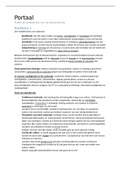Voorbeeld 3 van de 12 Oefenvragen
Dit zijn jouw voordelen als je samenvattingen koopt bij Stuvia:

Bewezen kwaliteit door reviews
Studenten hebben al meer dan 850.000 samenvattingen beoordeeld. Zo weet jij zeker dat je de beste keuze maakt!

In een paar klikken geregeld
Geen gedoe — betaal gewoon eenmalig met iDeal, creditcard of je Stuvia-tegoed en je bent klaar. Geen abonnement nodig.

Direct to-the-point
Studenten maken samenvattingen voor studenten. Dat betekent: actuele inhoud waar jij écht wat aan hebt. Geen overbodige details!
Veelgestelde vragen
Wat krijg ik als ik dit document koop?
Je krijgt een PDF, die direct beschikbaar is na je aankoop. Het gekochte document is altijd, overal en oneindig toegankelijk via je profiel.
Tevredenheidsgarantie: hoe werkt dat?
Onze tevredenheidsgarantie zorgt ervoor dat je altijd een studiedocument vindt dat goed bij je past. Je vult een formulier in en onze klantenservice regelt de rest.
Van wie koop ik deze samenvatting?
Stuvia is een marktplaats, je koop dit document dus niet van ons, maar van verkoper liviadekeijzer. Stuvia faciliteert de betaling aan de verkoper.
Zit ik meteen vast aan een abonnement?
Nee, je koopt alleen deze samenvatting voor €5,49. Je zit daarna nergens aan vast.
Is Stuvia te vertrouwen?
4,6 sterren op Google & Trustpilot (+1000 reviews)
Afgelopen 30 dagen zijn er 65040 samenvattingen verkocht
Opgericht in 2010, al 15 jaar dé plek om samenvattingen te kopen
Laatst bekeken door jou

Samenvatting ·
OML - samenvatting boek

Voordeelbundel ·
AQA GCSE Chemistry

Tentamen (uitwerkingen) ·
NUR 265 EXAM 4 STUDY GUIDE

Samenvatting ·
Samenvatting Portaal

Samenvatting ·
PSYCHOLOGY 324 Notes

Samenvatting ·
Samenvatting Onderwijskunde

Tentamen (uitwerkingen) ·
NSG 3370 Study Guide

Tentamen (uitwerkingen) ·
ACC 561 FINAL EXAM 4


